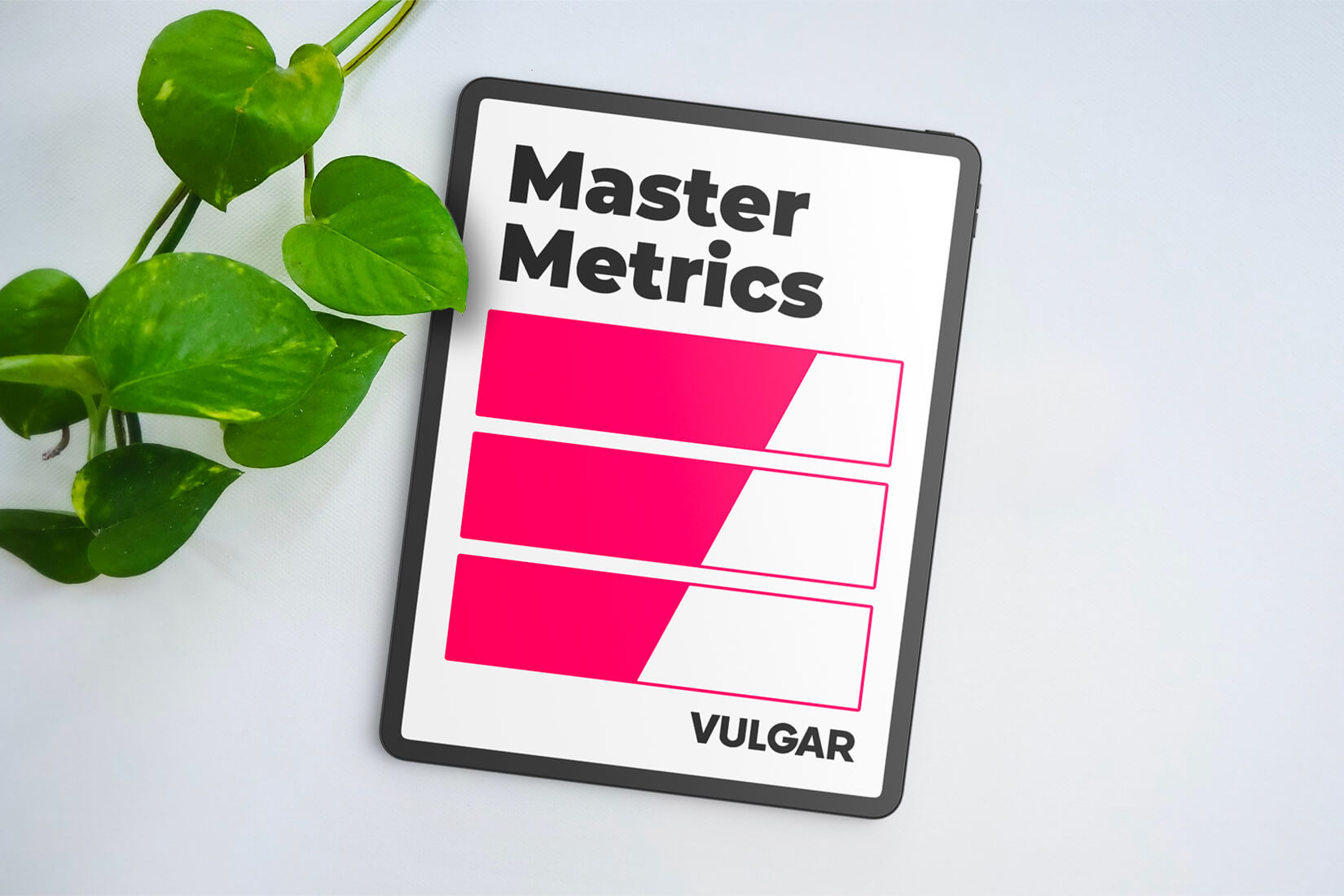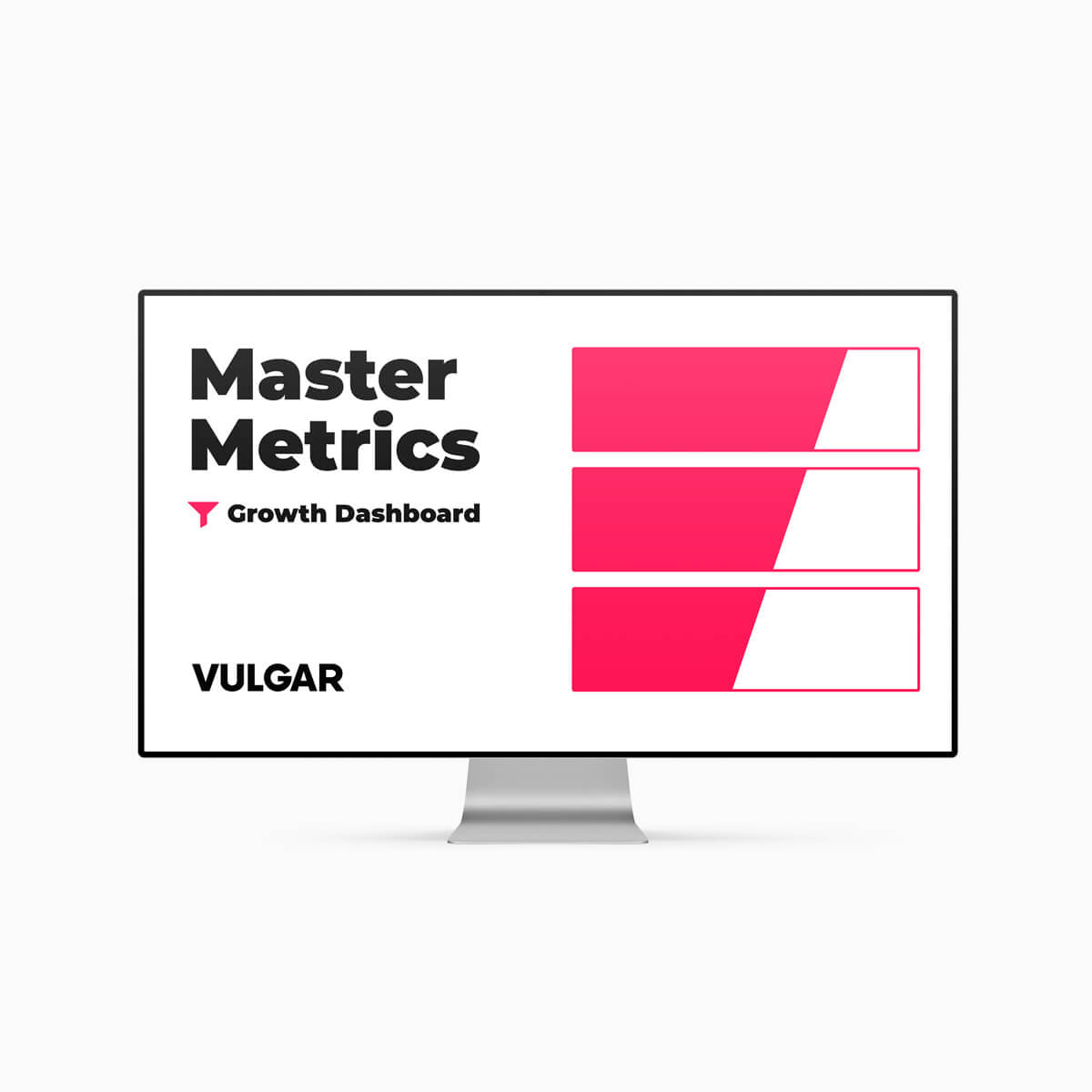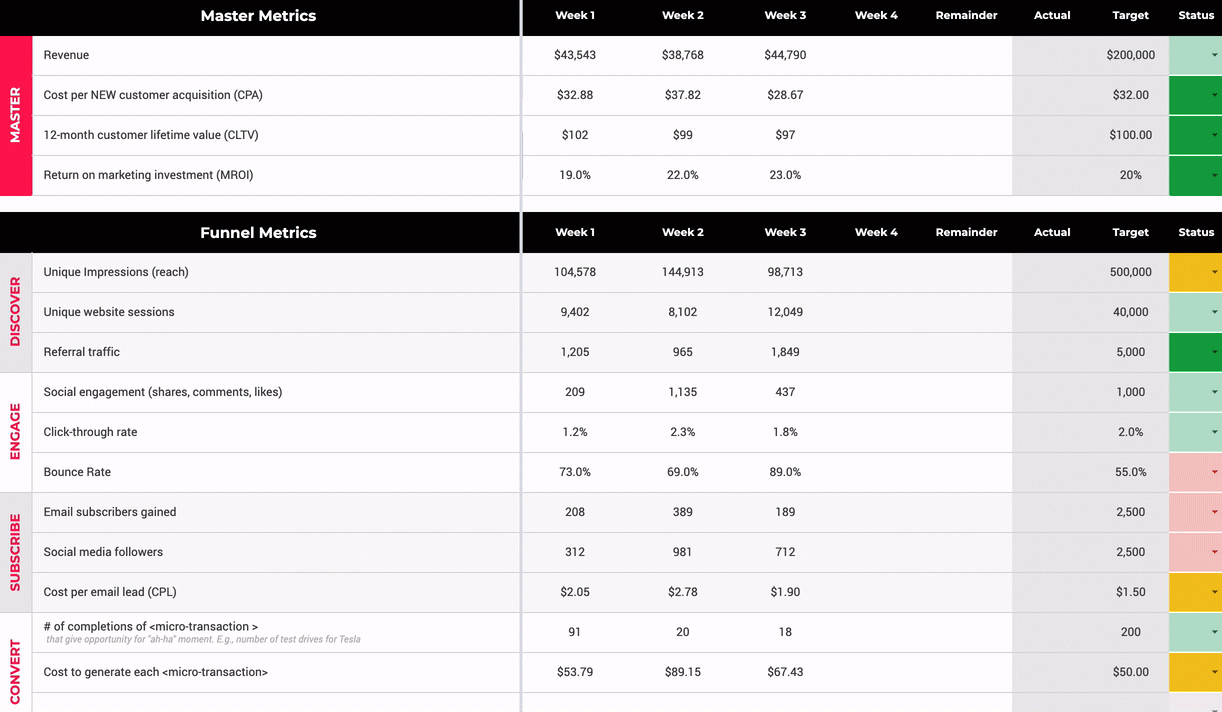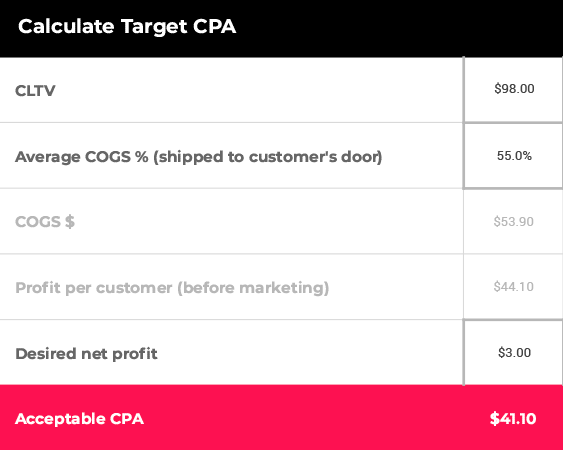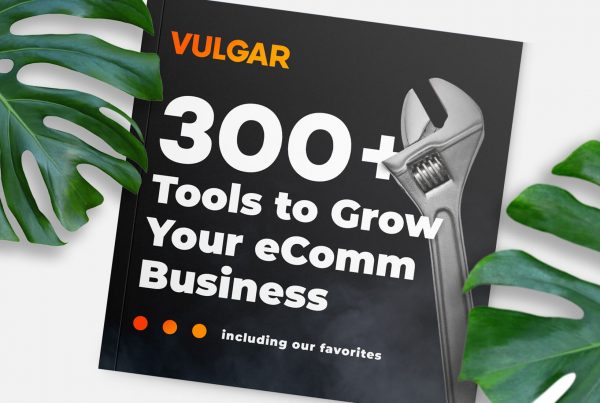There are hundreds of important metrics for ecommerce. It’s easy to get confused or distracted by all the KPIs you can measure. And not being clear on what should be measured and optimized will prevent you from scaling your business.
That’s why we’ve put together a template to help our ecommerce clients understand which metrics matter most, which metrics they should be tracking regularly, and what sections of the marketing funnel need specific metrics.
What eCommerce Metrics to Track
You’re probably thinking, “what are the most important metrics for ecommerce?” If you want to know how to scale an ecommerce brand, let’s start with the four metrics matter most. We call them the Master Metrics for Scale.
Master Metric 1
Revenue
It’s the lifeblood of any ecommerce business. If you don’t have revenue coming in and it’s not increasing over time, your business won’t scale. Period. Revenue is the king of the metrics because if you can generate it predictably, you can move on to scaling your business by optimizing profitability. Large companies will even acquire unprofitable ecommerce brands if they’re able to generate serious revenue. Why? Because revenue is the most challenging part and the big companies know they can fix the profitability part later.
Master Metric 2
Customer Lifetime Value
A lot of ecommerce brands try to scale their business based on their average order value, but this will limit how fast you scale. If you want to scale quickly, you’ll want to look more closely at customer lifetime value (CLTV) instead.
CLTV is the average amount a customer will spend with you over a certain period. Depending on your business and cash flow model, you should look at either 6-month or 12-month customer lifetime value—meaning how much, on average, customers spend with you over 6 months or 12 months.
Shopify stores can easily track CLTV with an app called Lifetimely, which instantly calculates it for you.
The beauty of CLTV is that it gives you a bigger picture of what each new customer is worth. That said, if your AOV and CLTV are essentially the same, there’s opportunity there. CLTV should be a great deal higher than AOV due to repeat purchases, upsells, and cross-sells. If it’s not, it’s time to make some changes in your marketing or ecommerce strategy.
Master Metric 3
Cost Per Customer Acquisition
Do you know how much it costs for your brand to get a new customer? You need to. Cost per acquisition, also known as CPA or CAC, is a critical metric for ecommerce businesses because it shows how efficient your marketing is performing. For ecommerce, depending on the product, a great CPA is anywhere from $30-$45 or more. Don’t expect a lower CPA if you want to scale your brand. Today’s media costs just won’t allow for it.
Remember, CPA will typically increase as you increase your marketing reach. That’s because as you expand reach, you’re serving ads to less qualified prospects. And these people require more convincing to purchase; thus, more marketing spend.
”Aiming for the lowest CPA is a mistake if you're trying to scale.

If you want to scale your ecommerce brand, you don’t want the lowest CPA possible. This will actually prevent you from scaling. If you shoot for the lowest CPA, you’ll find yourself constantly limiting marketing spend, cutting channels, and targeting only low-funnel audiences. It’s a scarcity mindset that results in plateaus in growth.
If you want to scale your ecommerce brand, you don’t want the lowest CPA possible. This will actually prevent you from scaling. If you shoot for the lowest CPA, you’ll find yourself constantly limiting marketing spend, cutting channels, and targeting only low-funnel audiences. It’s a scarcity mindset that results in plateaus in growth.
Instead, do the math to determine the maximum CPA you can have and still breakeven or make a small profit. Use this as your CPA benchmark. And remember that the brands that win are the ones that can spend the most to acquire each customer.
How to Calculate a Target CPA
Use our quick calculator to determine an acceptable or breakeven cost per acquisition for your brand.
Using CLTV instead of AOV in your calculation, you’ll see that you can spend significantly more on marketing to acquire each new customer. The longer your CLTV period—for example, 12 months versus 6 months—the more aggressive (eh, risky) your marketing plan will be. Keep this in mind. Calculating your target CPA with CLTV is leveraging your marketing budget. If you overleverage by using too long of a CLTV period, you could get burned. Keep this in mind; maybe start with a 3-month period, not 12.
Master Metric 4
Marketing Return on Investment (MROI)
The last Master Metric is return on marketing investment. Marketing ROI (MROI) gives you a sense if your marketing is working or not. There are many different ways to calculate ROI for marketing, and there’s a lot of debate around which attribution models are best. But rather than arguing about which metric calculation is the most accurate, we recommend a more straightforward approach that focuses on monitoring your ROI trend. First, here’s how to calculate a basic marketing ROI.
How to Calculate Marketing ROI

The formula gives you the return on investment for a given period of time. If you want to see the marketing ROI for last month, you would only use the revenue and costs accumulated in the previous month.
For marketing costs, you’ll want to add up, well, all your marketing costs. Deciding what you want to include is up to you. For most clients, we only use media spend in the sum of marketing costs. But if you want a more accurate or conservative picture, you can include nonrecurring production costs, agency fees, or any other marketing costs associated with generating revenue.
Whatever marketing costs you choose to include in your calculation, you must include them every month to properly compare each month to previous ones.
Some marketing costs you may consider including when calculating the marketing ROI metric:
- Facebook media spend
- Google media spend
- Amazon media spend
- Campaign production costs
- Agency fees
- PR fees
- Technology fees
- List rental costs
Important Metrics for eCommerce When Using a Marketing Funnel
The Master Metrics above are critical to scaling your business, but the crucial question is, what do you do to improve the Master Metrics? What metrics feed into and drive the overall performance of an eCommerce business?
This is where the marketing funnel is key to organizing all the metrics that matter for eCommerce. For our clients, we break up marketing plans into eight stages of the funnel. Each stage has its own handful of metrics that we consider key performance indicators (KPIs). We then use strategies, campaigns, and tactics purposefully contained in each stage to improve those KPIs.
”When each stage of the funnel hits its metrics, the whole is greater than the sum of the parts.

If you’re optimizing the KPIs in each stage of the funnel, then you’ll see the 4 Master Metrics improve.
Every ecommerce business is a bit different. Some brands will need to focus on different metrics and KPIs depending on their particular funnel. But in general, here are the funnel metrics and KPIs we use for ecommerce brands as a starting point. You can swap for others to suit your business. Only use a maximum of three per stage of the funnel.
- Unique Impressions (reach)
- Unique website sessions
- Referral traffic
- Social engagement
- Click-through rate
- Bounce rate
- Email subscribers
- Social media followers
- Cost per email lead (CPL)
- # of micro-transactions complete
- Cost to generate each micro-transaction
- # of special moments generated
- Email open rate
- # of sales
- Cost per acquisition
- ROAS
- # of product reviews
- Social shares
- # of referral sales
- Referral revenue generated
Use our free Google Sheet template.
eCommerce Performance Metrics for Diagnosing the Funnel
We only like to track and work toward 3 KPIs per stage of the funnel as outlined above to keep things hyperfocused and productive. But this doesn’t mean you shouldn’t look at other metrics. Use secondary performance metrics to diagnose why you’re not hitting KPIs, or better, why you’re crushing it in particular areas so you can keep doing it.
Let’s look at an example. Say we’re looking at the Unique Website Sessions metric in the Discover stage above. We notice that it’s down this month. That’s weird. It shouldn’t be. Now we start the diagnosis process. Why could our sessions be down?
First, we look at ad spend. It’s about the same as the previous months, so we shouldn’t expect to see a drop in traffic because of that. Next, we look at the ads we’re running in the Discover stage to see what’s happening. Bingo. We see our click-through rate has dropped. We’re getting nearly half the clicks we usually get. We immediately make some tweaks to the creative, and we get back on track for the month.
Again, use secondary ecommerce performance metrics to figure out why you’re not hitting the goals in each phase rather than in your high-level reporting dashboard.
How to Scale an Ecommerce Business Using Performance Metrics
The key to scaling an ecommerce brand is consistent measuring and improvement of the metrics that matter. Here’s the process that we take our clients through to do this. It really helps to use our free template.
What Metrics Should a Startup Measure?
A lot of startup founders ask us, “are the performance metrics for a startup different?” Short answer? No. Taking the same disciplined approach outlined above is probably even more critical for a startup. As a startup, you have a chance to build a well-oiled marketing machine before your company has formed bad habits or has a large team to retrain.
That said, the most significant difference when it comes to metrics for a startup is deciding which funnel stage you focus on optimizing first. For instance, a more established brand might be A-OK in the Discover stage. They might have a large media budget and lots of press that ensures many people discover them. So, they can be more focused on their Engage metrics and building strategies there.
For a startup, your business is likely to be weak in many areas. But here’s what you do. Start with the Master Metrics. Again, those metrics should always be your north star. Next, follow the same process above, determining the three metrics for all eight stages.
For early startups, concentrate on these three funnel stages first:
Refer to the breakdown of metrics for each stage above. Once you have a system in place and begin to see results in these three areas, start building out strategies and tactics for these three phases:
The metrics in these stages bring lead generation into your ecommerce strategy. And lead generation is key to scaling an ecommerce brand online. Lastly, turn your attention to the last two stages:
Of course, every company is different, but in general, that’s how we would approach scaling an ecommerce startup from scratch.
Need Help Determining Which eCommerce Metrics to Track?
Figuring out which ecommerce metrics matter most can be challenging. We can help get you started. Hit us up for a free marketing plan. We’ll put your business under a microscope and give you over a dozen ideas to help you scale.
